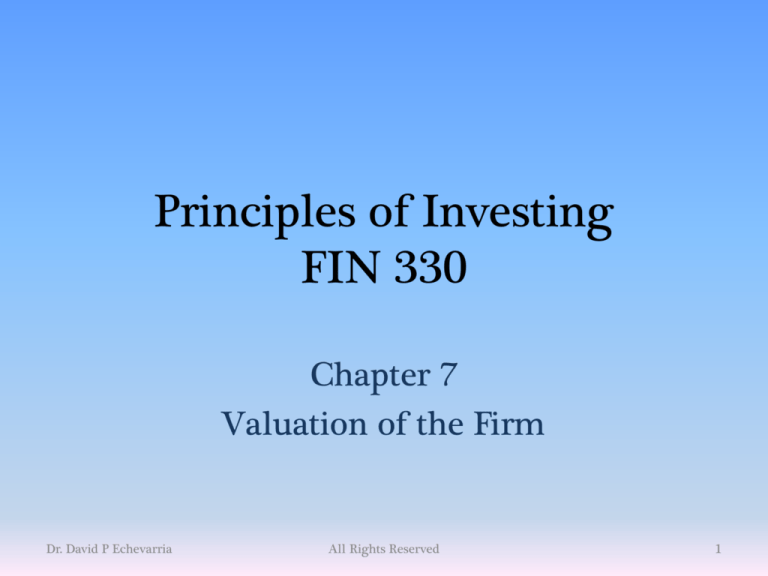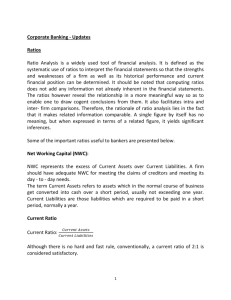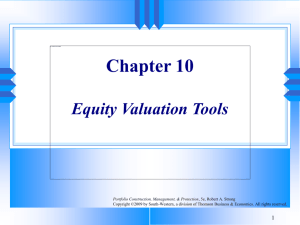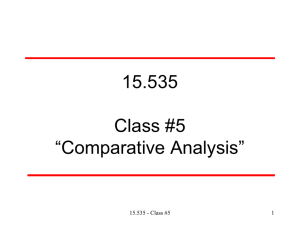
Principles of Investing
FIN 330
Chapter 7
Valuation of the Firm
Dr. David P Echevarria
All Rights Reserved
1
Student Learning Objectives
A.
B.
C.
D.
E.
Elements of Company Analysis
A company’s Competitive Position
Nature of Management
Evaluating Quality of Management Skills
Financial Ratio Analysis
Elements of Company Analysis
A. Description of business and properties
B. Historical Financial Performance data
C. Details about senior management
Competitive Position
A.
B.
C.
D.
E.
F.
Sales Revenue (growth)
Profitability (trend)
Product line (turnover, age)
Operating efficiency
Pricing Strategy
Patents and technology
Nature of Management
A. Organizational performance
1. Effective application of company resources
2. Efficient accomplishment of company goals
B. Management Functions
1.
2.
3.
4.
Planning - setting goals/resources
Organizing - assigning tasks/resources
Leading - motivating achievement
Controlling - monitoring performance
Review of Financial Statements
A. Balance Sheet
1. Snapshot of company’s assets, Liabilities and Equity.
B. Income statement
1. Sales, expenses, and taxes incurred to operate
2. Earnings per share: Net income / number of shares
outstanding
3. Cash flow statement: Sources and uses of funds
C. Are financial statements reliable?
1. G.A.A.P. vs Cleverly Rigged Accounting Ploys
2. See Alexander Briloff brief on FSA
Financial Analysis Ratio Categories
A. Liquidity Ratios: ability to meet maturing
obligations
B. Asset Management Ratios: measure
efficiency of asset management
C. Debt Management ratios: use of debt to
finance asset structure.
D. Profitability Ratios: measure ability to
control costs, asset investment returns
Market Valuation Ratios
A. Price Earnings Ratio (P/E) = P0 / EPS
1. EPS = Net Income / # Shares Outs.
2. Primary, Fully Diluted
3. Before / Including Extraordinary Items &
Discontinued Operations (charges net of
taxes)
B. Book Value (BV) = Equity / # Shares Out
DuPont System of Financial Analysis
Net Inc =
N.P.M. =
Net Sales
COGS
SGA
INTEXP
TAXES
ROA =
Net Sales
T.A.T.O. =
Total Assets
ROE =
Total Debt =
Current Liabilities
+
L-T Debt =
Total Assets =
Current Assets
+
Fixed Assets
1-DR =
A/P
N/P
Accrual
Bonds
Estimating Earnings and Fair Market
Value for Equity
A. Six Steps
1.
2.
3.
4.
5.
6.
Estimate next year’s sales revenues
Estimate next year’s expenses
Earnings = Revenue - Expenses
Estimate next year’s dividend per share
Earnings per Share vs. dividend payout strategy
Estimate the fair market value of stock given next
years earnings, dividend, ROE, and growth rate for
dividends Using Gordon Growth model or P/E Model
Basic Valuation Concepts
A. Dividend Valuation Models: Gordon Growth
(see Eq. 7-5)
B. Earnings Valuation (P/E ratio) – a measure
of attractiveness to investors
C. Capital Asset Pricing Model (CAPM)
1. Expected returns a function of risk free rates,
beta, and a risk premium (see Eq. 7-2)
2. Beta (b) = a measure of risk relative to the broad
market
3. Value = Cash Flow / E(r)
Dr. David P Echevarria
All Rights Reserved
11
Sustainable Growth Measures
A. Earnings growth is [partly] a function of
profits reinvested in the firm (retention
ratio)
B. Sustainable Growth rate = ROE * RR
C. ROE = Return on Equity = Net Income /
Stockholder Equity
D. Growth companies typically pay small
dividends and reinvest most of their
earnings
Dr. David P Echevarria
All Rights Reserved
12
Forecasting Earnings
A. Least Squares (regression analysis): EPS
over time
B. Income Statement method (see Table 7-9
for example of methodology)
1.
2.
3.
4.
Forecast Revenues and Expenses
Rev – Exp = Profits
Profits / # shares outstanding = EPS
EPS / Ke = Price per share
Dr. David P Echevarria
All Rights Reserved
13
Homework
A. Discussion Questions: 2, 3, 5, 11, 19
B. Problems: 2, 5, 8, 15
Dr. David P Echevarria
All Rights Reserved
14












